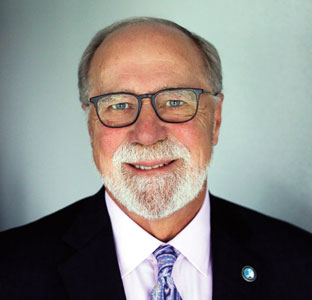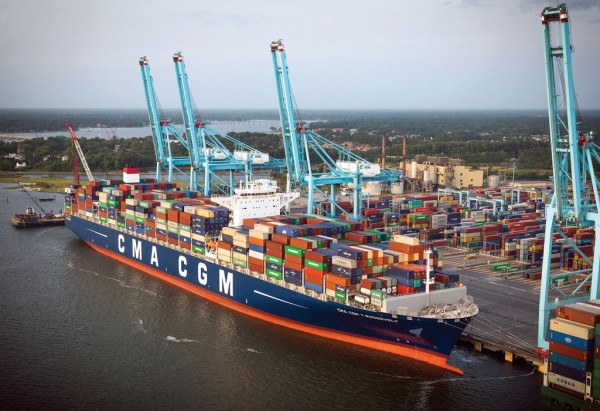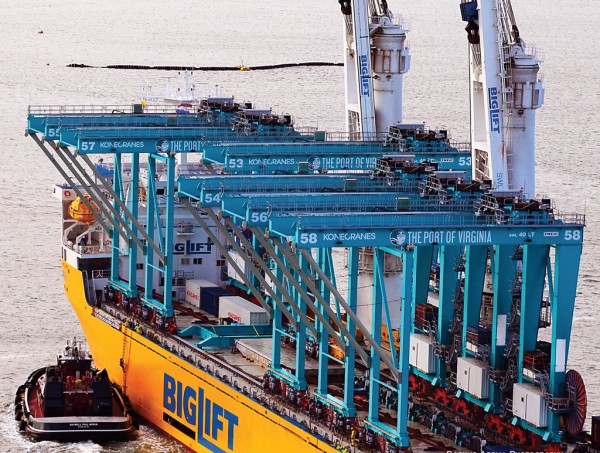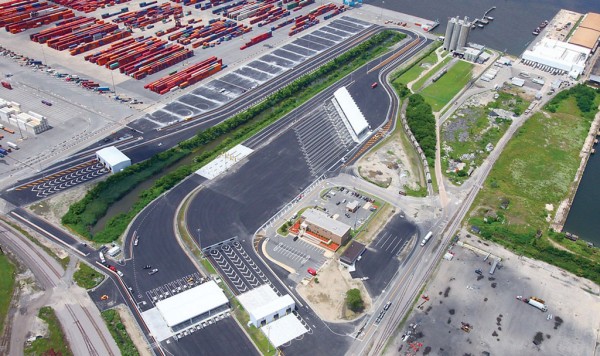With plans advancing for a wider, 55-foot-deep harbor, as well as enhanced infrastructure and systems coming online, The Port of Virginia is assertively preparing to efficiently handle even more containers from ever-larger vessels.
“I think we’re moving at a pretty good clip.” John F. Reinhart, the Virginia Port Authority’s chief executive officer and executive director, told AJOT, citing numerous efforts to build upon record containerized cargo throughput in addition to delivering the U.S. East Coast’s deepest, widest, safest harbor.

Since Reinhart took the VPA helm in February 2014, The Port of Virginia has seen its yearly container volume rise nearly 20 percent, to an all-time high of 2.84 million 20-foot-equivalent units in calendar 2017, while current endeavors aim to add another 1 million TEUs of annual throughput capacity by fall 2020.
“Our goal is to break the 3 million [TEU] threshold this year, and we are trending toward just that,” he said.
Whereas Reinhart, who came to VPA after retiring as chief executive officer of Maersk Line Ltd., is quick to humbly give credit to other members of the port’s team and collaborating stakeholders, the impact the longtime ocean carrier executive is having in the Old Dominion is undeniable, and he is making good on his promises.
A year ago, Reinhart told AJOT that 2017 would bring The Port of Virginia containerships with capacities of 13,000 TEUs and more, and, indeed, when CMA CGM’s 14,400-TEU-capacity Theodore Roosevelt called in August at Virginia International Gateway, it signified the largest containership to be worked at a U.S. East Coast port. Calls by such big boxships have now become a regular occurrence.
Because, while container volume is growing, the number of Virginia ship calls is declining at an annual rate of 9 percent, the challenge – beyond providing a deep and wide enough harbor – has been to facilitate the smooth flow by truck and rail of thousands of boxes moving off and on megavessels.

An ambitious construction program is well under way, entailing some $700 million of capital projects at the VPA’s two main container facilities.
In February, The Port of Virginia received six rail-mounted gantry cranes – the first delivery in an initiative to ultimately bring in a total of 86 RMGs, with 26 heading to the 291-acre Virginia International Gateway site in Portsmouth and 60 destined for the 567-acre Norfolk International Terminals facility.
Reinhart termed the arrival of the first new RMGs “an exceptionally exciting moment,” adding that another half-dozen such gantries are scheduled to arrive every six succeeding weeks.

Shortly after delivery of the six RMGs, The Port of Virginia had another heavylift ship arrive at Virginia International Gateway, holding the component parts for two cantilever rail-mounted gantry cranes, the first of four such cranes, with these first two slated to be operational at new VIG rail stacks by June.
Also, 20 new shuttle trucks are on their way to The Port of Virginia from Europe, and 20 new translifter units are headed to VIG as well.
At the same time, a berth extension project is moving forward toward the pouring stage of a contiguous 4,000-foot-long quay. By Christmas, VIG is to receive four ship-to-shore cranes billed as being the tallest with longest outreach in the United States, at 172 feet from the boom to the dock, compared with 155 feet for current VIG cranes. The big new units are slated to be operational by February 2019.
“We want to be able to handle whatever ships may ever come to the United States,” Reinhart said.
By spring 2019, plans call for having an additional 520,000 containers of annual throughput capacity in place at VIG, taking the annual flow capability of that terminal alone to 1.2 million TEUs.
At the Norfolk International Terminals container facility, which is to get 60 of the new RMGs plus new shuttle trucks as well, 30 rail-mounted gantry stacks are being created and the terminal flow is being upgraded, with traditional straddle carrier operation being replaced with a semiautomated operation deploying the RMGs and the new Navis N4 terminal operating system being implemented at all VPA terminals.
“We’re just trying to speed the flow across the terminals.” Reinhart said.
In June 2017, VPA opened the $42 million, 26-lane modern North Gate Complex at NIT, with direct feed to the Interstate 564 intermodal connector, which opened six months later. Thus trucks serving NIT no longer have to traverse residential streets but rather can move right out of the terminal onto freeway ramps, unimpeded by traffic and stoplights.
Meanwhile, the rollout of VPA’s truck appointment system, beginning in March at NIT, is to expand over the summer to include VIG and Portsmouth Marine Terminal. Truckers should be able to book reservations online through the PRO-PASS website implemented last year.

All told, VPA is looking to add 1 million more TEUs of capacity by third quarter of 2020, Reinhart said, adding, “so we have to be able to have the systems and the terminal operating software designed to flow that quickly across the facility.”
Another factor helping speed cargo to final destinations is the extensive use of Norfolk Southern and CSX rail at The Port of Virginia. According to Reinhart, the 36.3 percent of the port’s freight that moves via intermodal rail is the highest such figure among East Coast ports. With modernization of the rail yard at VIG, Reinhart projects a 150 percent increase in capacity to swiftly move that rail freight, with another 360,000 rail moves achievable if such capability is totally utilized. That would propel Virginia into being the first East Coast port to move more than 1 million containers a year by rail.
With all that said, Virginia’s progress on the harbor project front is probably what is drawing the most industry attention.
“Everything is authorized,” Reinhart said, referring to January approval by the U.S. Army Corps of Engineers of the project’s national economic development benefit plan. “They just need to go through the formalities, so we will be wider, deeper and safer.”
The Port of Virginia already receives the largest containerships calling the East Coast, but increasing channel depth to 55 feet from its present 50 feet and, just as importantly, widening the channel east of the Chesapeake Bay Bridge-Tunnel to 1,300 feet from its current 1,000 feet, should allow the big containerships to load to their limits (particularly important as Virginia is drawing a growing number of first-in and last-out calls) and facilitate safe two-way traffic.
While the Corps of Engineers proceeds with its chief’s report, Virginia port officials are actively seeking funding via U.S. Congress, as well as further support from the Commonwealth of Virginia, which already has earmarked $20 million to begin preliminary engineering and design work by the end of April.
Reinhart said he looks to get the entire harbor project completed by 2024, “pretty much allowing for all the natural challenges,” from environmental issues to getting channel-deepening equipment in place.
“The good news is that we’re the first port that has hit the 3-by-3-by-3 with the Army Corps of Engineers because of our close coordination, collaboration and communication with the Army Corps of Engineers,” Reinhart said, talking about the target of three years or less for each of three stages – for study, engineering and project completion.
“The amount of support and coordination by all stakeholders, the Army Corps of Engineers, the state itself and the port has been exceptional,” Reinhart said. “We’re very pleased to get moving to the next phase, the outcome being Virginia will be the deepest, safest harbor on the East Coast when completed.”





